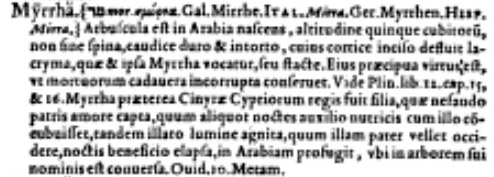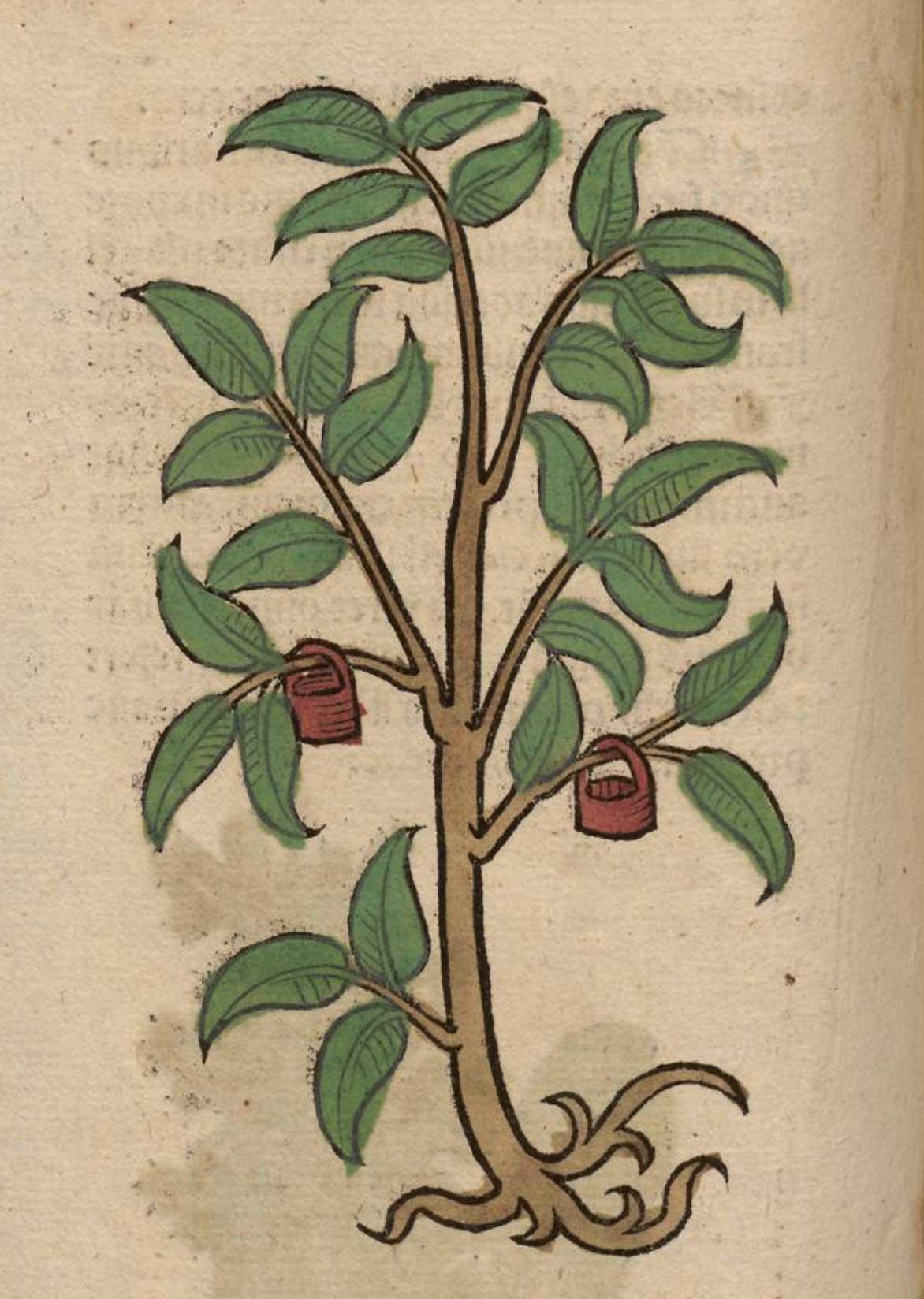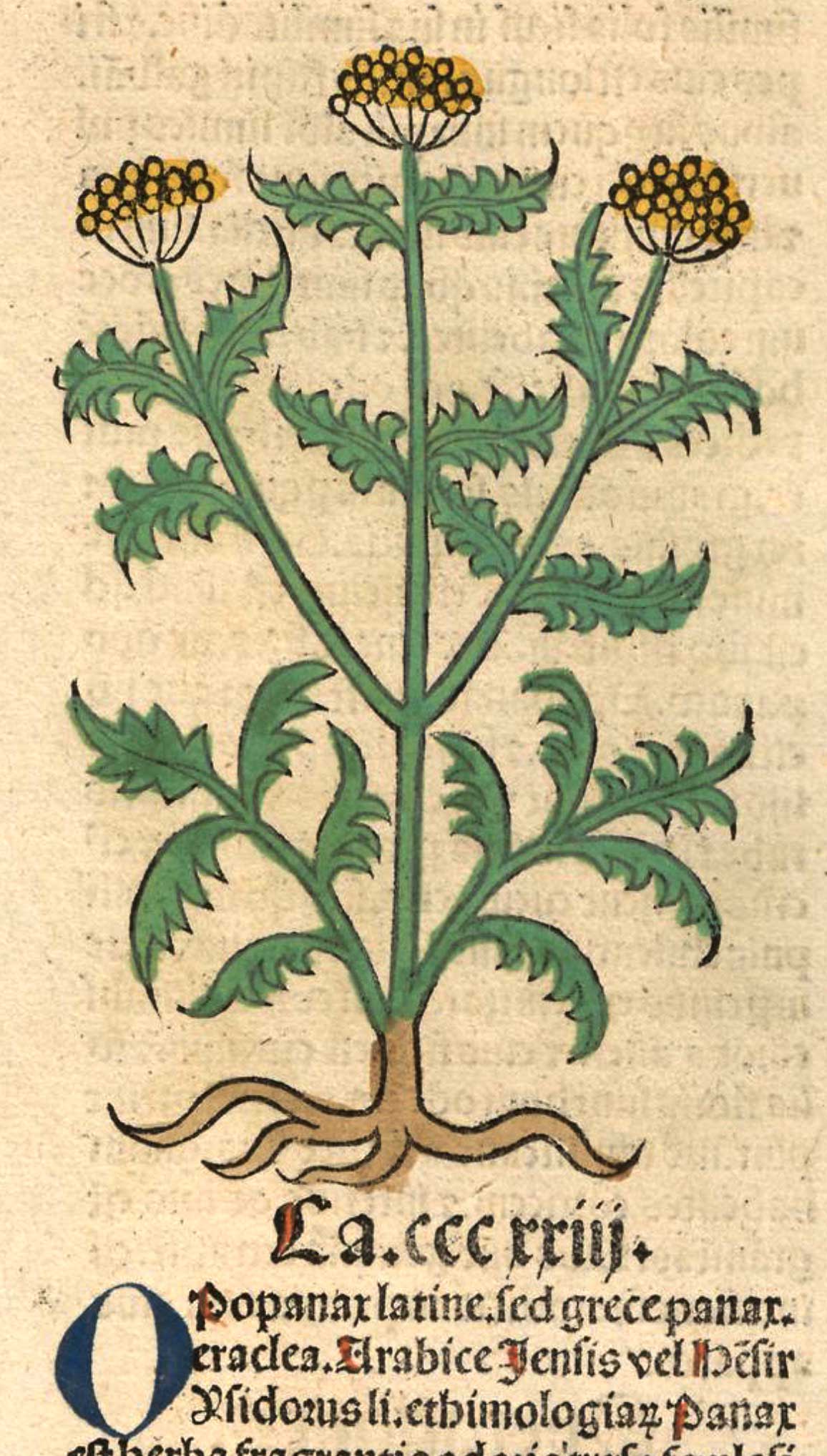A plant vaunted by the Indians, the Arabs, and the Sabines.
Notes
Balsamus (text)
Balsamus
Opopanax
myrrhe

Calepino’s entry for myrrha (in Latin)
myrrhe
Let the land of Panchaia be rich in balsam, let it bear its cinnamon, its costum, its frankincense exuding from the trees, its flowers of many sorts, provided it bear its myrrh-tree, too: a new tree was not worth so great a price.
Myrrha
Myrrha. Arabs, pinguis, cynareis … Hanc autem arbusculam succo distillatem habent Arabia, Assyria & Orontes fluvius. De prædicto incestu Ovid Lib. 10. Metamorph.
Myrrh
Divisae arboribus patriae; sola India nigrum
Fert ebenum; solis est turea virga Sabaeis.
— Virgil Georgics ii. 116-7.
“Myrrha multis in locis Arabiae gignitur” (Pliny. xii 15, § 33.)
myrrhe
Gomme résine d’une térébinthacée Balsamodendron Ehrenbergianmum, Berg. qu’Olivier identife au B. opobalsamum, Kunt. Bailon prétend que la myrrhe du commerce provient encore en partie du B. Kataf, Kunt. (Paul Delaunay)
myrrhe
Notons que le myrrhe est toujours associé à l’Arabie (cf. par exemple, Calépinus, Lexicon, s.v. ; Textor, Epitheta, s.v.
myrrh
myrrh. Forms: myrra, murra, murre, myrre, mirre, merre, mirr, myre, mir, mere, myr, myrr, mirrhe, mirrh, myrrhe, myrrh. [Old English myrra, myrre, murra = Greek murra, of Semitic origin (Arabic murr, Hebrew mo¯r).]
A gum-resin produced by several species of Commiphora (Balsamodendron), especiallyC. Myrrha, used for perfumery and as an ingredient in incense. Also medical, the tincture made from this. In early use almost always with reference to the offering of myrrh by the Magi to our Lord.
C. 825 Vespasian psalter Psalms xliv. 9 Myrre & dropa & smiring.
C. 975 The Rushworth Gospels Matthew ii. 11, & ontynden heora goldhord brohtun him lac gold recils & murra [Ags. Gospel myrre, Hatton Gospel mirre].
C. 1000 Ælfric Homer (Th.) I. 118 Myrra deð… þæt þæt deade flæsc eaðelice ne rotað.
C. 1200 Trinity College homilies Homer 45 Gold bicumeð to kinge. Recheles to gode. mirre to deaðliche men.
A. 1300 Cursur Mundi (The Cursur of the World) 11502 Attropa gaf gift o mir, A smerl o selcuth bitturnes.
C. 1386 Geoffrey Chaucer Knight’s Tale 2080 And garlandes hangynge with ful many a flour, The Mirre, thencens, with al so greet odour.
C. 1450 John Myrc Mirc’s Festial 49 Myrre ys an oynement þat kepyth ded bodyes from rotyng.
? 1550 John Bale The image of both churches Ch. i. ii. D. v, The odoriferous myrrha geueth forth the swete smelle of all good christen workes.
1652 Richard Crashaw Carmen Deo Nostro (1904) 198 Mountains of myrrh, and Beds of species.
1672 Wiseman Wounds ii. i. 2 Put a Pea in the middle of it, with Tincture of Myrrhe and Honey of Roses.
Any shrub or tree that yields the gum-resin, esp. Commiphora (Balsamodendron) Myrrha
C. 1402 John Lydgate The complaint of the black knight 66, I saw ther Daphne… The myrre also, that wepeth ever of kinde.
A. 1450-1530 The myroure of our Ladye 285 Myrre is a tree that groweth fyue cubytes in lengthe.
1603 Michael Drayton England’s heroicall epistles. iv. 141 Turn’d into a Myrrhe, Whose dropping Liquor ever weepes for her.
1634 John Milton Comus 937 With Groves of myrrhe, and cinnamon.
Opopanax
Opopanax, also known as opobalsam, refers to a number of gum resins (natural substances that are a mixture of water-soluble gums and alcohol-soluble resins) traditionally considered to have medicinal properties. Pliny (Historia Naturalis) and Dioscorides (De Materia Medica) described various kinds with uncertain identifications, which have been distinguished as:
- A species of Centaurea
- Lovage (Levisticum officinale)
- Yarrow (Achillea millefolium)
- Echinophora tenuifolia (Umbelliferae)
- Ferula opopanax, also known as Opopanax chironium (Umbelliferae)
- Fig-leaved cow parsnip, Heracleum panaces (or other species of Heracleum)
In recent times, the main source of commercial opopanax is from species of Commiphora, particularly C. erythraea and C. kataf. (Some sources suggest the entire production is from C. erythraea var. glabrescens, a tree growing in Somalia.[6]) Myrrh is also obtained from Commiphora species.
Myrrh
Myrrh (from Aramaic) is a natural gum or resin extracted from a number of small, thorny tree species of the genus Commiphora. Myrrh resin has been used throughout history as a perfume, incense, and medicine. Myrrh mixed with wine was common across ancient cultures, for general pleasure and as an analgesic.
The word myrrh corresponds with a common Semitic root m-r-r meaning “bitter”, as in Aramaic ܡܪܝܪܐ murr and Arabic مُرّ murr. Its name entered the English language from the Hebrew Bible, where it is called מור mor, and later as a Semitic loanword was used in the Greek myth of Myrrha, and later in the Septuagint; in the Ancient Greek language, the related word μῠ́ρον (múron) became a general term for perfume.


